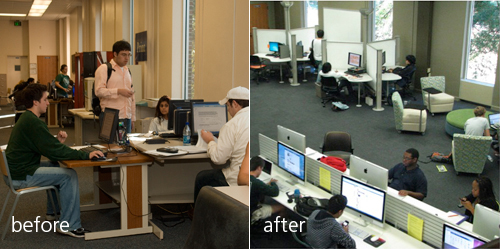Campus News
October 29, 2010
Oxford Library uses proof of concept to test new design
On their first visit to the library this semester, Oxford College sophomores may have done a double take. Over the summer, the first floor of the Oxford Library had undergone a radical makeover, shedding its former interior space design and jumping squarely into the 21st century. The transformation came about thanks to the efforts of a team of Oxford forward-thinkers.
Proof of concept
The current building was completed in 1970, and a new library and academic commons has been a goal of Oxford’s long-range strategic plan for some years.
Constructing a new building seemed the best way to address the changed mission of libraries — digital and online sources, digital hardware, collaborative study spaces and librarian-led instruction.
Dean Stephen Bowen, Associate Dean and College Librarian Kitty McNeill, and others at Oxford knew how a new library should look and work, but translating this vision for alumni and potential donors was difficult.

Bowen had come to Oxford from Michigan Technological University, where educating future engineers and designers meant teaching them “proof of concept” methods. In the business of engineering and technology, a proof of concept--a one-off prototype--is often created to allow investors and other stakeholders to see a product idea come to life. Why not, he thought, create a proof of concept for the Oxford Library?
Students get a say
First, funding was needed. Hugh Tarbutton Jr. ’84Ox, who had already made a significant contribution to the fund to build the new library and academic commons, agreed to allow those funds to be used for the proof of concept.
McNeill and her team, including Stuart Adler and Stephanie Davies-Dickinson of University Campus Planning and local architect Andy Akard, planned and implemented the project in six months.
McNeill got students in on the initial design to see how they wanted to use the library.
“The innovative approach to student involvement in the design process is a big factor in the positive response to the new library spaces,” says Charles Forrest, director of library facilities for University Libraries, who was also on the project team.
“The opportunity to test new concepts in furniture, shelving, services and technology will inform the design of the library and academic commons.”
Space opens ideas
A key component to the open and inviting look to the new space design is the use of compact shelving—moveable bookshelves mounted on tracks—which eliminates aisles and creates very dense storage.
The space saved accommodates a dedicated area for library instruction, an island of computers for research and movable study pods equipped with computers. The furniture, equipment and finishes can all be incorporated into future improvements.
The discovery of how much space can be freed with compact shelving and how effectively the additional space can be used in a 21st-century library has caused Oxford to think differently about its library and academic commons building.
A structural review is currently under way on the second floor of the library to determine if it too can support compact shelving.
Oxford will be working with architects over the next few months to consider whether a renovation of the second floor and an addition to the building will meet its vision for the library and academic commons.
That would significantly reduce the cost of the project and speed the day when Oxford has a library of both the quality and size to support its students.
In the meantime, students have embraced the new library environment with an enthusiastic thumbs-up.
